| Listing 1 - 10 of 25 | << page >> |
Sort by
|
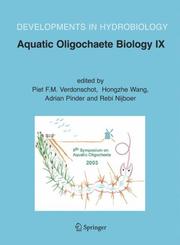
ISBN: 1281067393 9786611067397 1402053681 1402047819 9400797958 Year: 2006 Volume: v. 564 Publisher: Dordrecht : Springer,
Abstract | Keywords | Export | Availability | Bookmark
 Loading...
Loading...Choose an application
- Reference Manager
- EndNote
- RefWorks (Direct export to RefWorks)
This volume contains selected papers from the 9th Symposium on Aquatic Oligochaeta, 6–10 October 2003, Wageningen, The Netherlands. 18 contributions deal with the biology of aquatic oligochaetes, and represents a mixture of the fields of taxonomy, anatomy, morphology and physiology, life history, ecology, sludge studies and toxicology. This wide scope is in line with the recent trends in oligochaete research, with a special interest in sludge studies. Research teams from France, Japan, United States, Czech Republic, The Netherlands, Spain, Italy, Germany, Hungary and China present the latest developments on annelid studies and also reflect a balanced mixture of geographical areas, as well as biological topics.
Oligochaeta --- Aquatic invertebrates --- Aquatic biology --- Hydrobiology --- Water biology --- Aquatic sciences --- Biology --- Aquatic animals --- Invertebrates --- Chaetopoda --- Oligochaete worms --- Oligochaetes --- Oligochaets --- Oligochetes --- Clitellata --- Aquatic biology. --- Freshwater & Marine Ecology. --- Aquatic ecology . --- Ecology
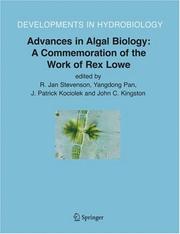
ISBN: 128114049X 9786611140496 1402050704 1402047827 9048171946 Year: 2006 Publisher: Dordrecht : Springer,
Abstract | Keywords | Export | Availability | Bookmark
 Loading...
Loading...Choose an application
- Reference Manager
- EndNote
- RefWorks (Direct export to RefWorks)
Advances in Algal Biology: A Commemoration of the Work of Rex Lowe was written by students and colleagues of Rex Lowe to acknowledge his esteemed career that included exceptional contributions to research and teaching. Papers in the book cover a variety of topics in algal ecology, focusing on benthic algal ecology in freshwater ecosystems. The studies provide an unusual combination of small-scale experiments and large-scale regional surveys that bridge both basic and applied ecology. Ecologists, limnologists, phycologists, and environmental scientists will find valuable contributions to the development and application of algal research.
Algology. --- Phycology --- Botany --- Algae --- Aquatic biology. --- Ecology. --- Botany. --- Freshwater & Marine Ecology. --- Plant Sciences. --- Hydrobiology --- Water biology --- Aquatic sciences --- Biology --- Botanical science --- Phytobiology --- Phytography --- Phytology --- Plant biology --- Plant science --- Natural history --- Plants --- Balance of nature --- Bionomics --- Ecological processes --- Ecological science --- Ecological sciences --- Environment --- Environmental biology --- Oecology --- Environmental sciences --- Population biology --- Ecology --- Aquatic ecology . --- Ecology . --- Plant science. --- Aquatic biology --- Floristic botany

ISBN: 1280864915 9786610864911 1402052731 1402052723 Year: 2006 Volume: v. 85 Publisher: Dordrecht, the Netherlands : Springer,
Abstract | Keywords | Export | Availability | Bookmark
 Loading...
Loading...Choose an application
- Reference Manager
- EndNote
- RefWorks (Direct export to RefWorks)
This monograph is the second of a series treating the hypotrichs, a major part of the spirotrichous ciliates. The urostyloids are characterised by a zigzag-arrangement of the ventral cirri. Like the first part of the series, the Oxytrichidae, it summarises the morphological, morphogenetic, faunistic, and ecological data from the past 230 years, scattered in more than 1300 references from all over the world. Dichotomous keys lead to 36 genera and subgenera comprising 153 species illustrated by more than 2100 figures, including original ones. The treatise offers taxonomists, cell biologists, and
Hypotrichida --- Hypotricha --- Hypotrichia --- Hypotrichina --- Hypotrichorida --- Hypotrichous ciliates --- Hypotrichs --- Spirotricha --- Invertebrates. --- Aquatic biology. --- Zoology. --- Freshwater & Marine Ecology. --- Animal Systematics/Taxonomy/Biogeography. --- Biology --- Natural history --- Animals --- Hydrobiology --- Water biology --- Aquatic sciences --- Invertebrata --- Aquatic ecology . --- Animal systematics. --- Animal taxonomy. --- Animal classification --- Animal systematics --- Animal taxonomy --- Classification --- Systematic zoology --- Systematics (Zoology) --- Taxonomy, Animal --- Zoological classification --- Zoological systematics --- Zoological taxonomy --- Zoology --- Aquatic biology --- Ecology

ISBN: 1280613068 9786610613069 3540300163 3540300147 Year: 2006 Publisher: Berlin, Heidelberg : Springer Berlin Heidelberg : Imprint: Springer,
Abstract | Keywords | Export | Availability | Bookmark
 Loading...
Loading...Choose an application
- Reference Manager
- EndNote
- RefWorks (Direct export to RefWorks)
Increasing awareness of the deleterious effects of toxic components in antifouling coatings has raised interest in the potential for nontoxic alternatives. This book examines how marine organisms from bacteria to invertebrates and plants use chemicals to communicate and defend themselves. Chemicals that prevent colonisation of living surfaces are particularly pertinent to antifouling technology and may inspire new solutions. The challenge is to identify such compounds, identify the means for sustainable production and incorporate them into coatings to give long-term antifouling efficacy.
Marine biotechnology. --- Marine organisms --- Paint, Antifouling. --- Environmental chemistry. --- Chemical defenses. --- Chemistry, Environmental --- Chemistry --- Ecology --- Antifouling paint --- Fouling --- Ships --- Aquatic organisms --- Marine biology --- Biotechnology --- Painting --- Biochemistry. --- Biotechnology. --- Aquatic biology. --- Animal Biochemistry. --- Freshwater & Marine Ecology. --- Hydrobiology --- Water biology --- Aquatic sciences --- Biology --- Chemical engineering --- Genetic engineering --- Biological chemistry --- Chemical composition of organisms --- Organisms --- Physiological chemistry --- Medical sciences --- Composition --- Aquatic ecology . --- Aquatic biology
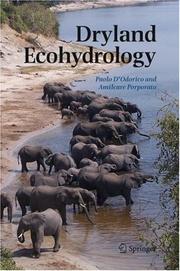
ISBN: 1402042590 940079469X 9786610459551 1280459557 1402042604 1402042612 Year: 2006 Publisher: Dordrecht : Springer Netherlands : Imprint: Springer,
Abstract | Keywords | Export | Availability | Bookmark
 Loading...
Loading...Choose an application
- Reference Manager
- EndNote
- RefWorks (Direct export to RefWorks)
By combining the analysis of biotic and abiotic components of terrestrial ecosystems, this volume provides a synthesis of material on arid and semiarid landscapes, which is currently scattered in a number of books and journal articles. The focus on water-limited ecosystems is motivated by their high sensitivity to daily, seasonal, and decadal perturbations in water availability, and by the ecologic, climatic, and economic significance of most of the world's drylands. Conceived as a tool for scientists working in the area of the earth and environmental sciences, this book presents the basic principles of eco-hydrology as well as a broad spectrum of topics and advances in this research field. The chapters have been contributed by authors with different expertise, who work in several arid areas around the world. They describe the various interactions among the biological and physical dynamics in dryland ecosystems, starting from basic processes in the soil-vegetation-climate system, to landscape-scale hydrologic and geomorphic processes, ecohydrologic controls on soil nutrient dynamics, and multiscale analyses of disturbances and patterns.
Life sciences. --- Geography. --- Ecology. --- Aquatic ecology. --- Plant ecology. --- Life Sciences. --- Plant Ecology. --- Geography, general. --- Freshwater & Marine Ecology. --- Terrestial Ecology. --- Aquatic biology. --- Balance of nature --- Biology --- Bionomics --- Ecological processes --- Ecological science --- Ecological sciences --- Environment --- Environmental biology --- Oecology --- Environmental sciences --- Population biology --- Cosmography --- Earth sciences --- World history --- Hydrobiology --- Water biology --- Aquatic sciences --- Botany --- Plants --- Ecology --- Phytoecology --- Vegetation ecology --- Ecology . --- Aquatic ecology . --- Aquatic biology --- Floristic ecology
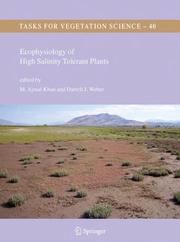
ISBN: 1280610999 9786610610990 1402040180 1402040172 1402092989 Year: 2006 Publisher: Dordrecht ; [Great Britain] : Springer,
Abstract | Keywords | Export | Availability | Bookmark
 Loading...
Loading...Choose an application
- Reference Manager
- EndNote
- RefWorks (Direct export to RefWorks)
This volume presents new and additional information about the physiology and ecology of halophytic plant species and saline ecosystems. The halophytes are highly specialized plants, which have greater tolerance to salt. They can germinate, grow and reproduce successfully in saline areas which would cause the death of regular plants. Most halophytic species are found in salt marsh systems along seashores or around landlocked inland lakes and flat plains with high evaporation. The halophytes play very significant role in the saline areas specially in the coast by overcoming the salinity in different ways, viz. with regulating mechanisms in which excess salts are excreted and with out regulating mechanism, which may include succulents or cumulative types. Besides that they protect coast from erosion and cyclones, provide feeding ground and nursery for fish, shrimps and birds. Halophytes get increasing attention today because of the steady increase of the salinity in irrigation systems in the arid and semi-arid regions where the increasing population reaches the limits of freshwater availability. In many countries, halophytes have been successfully grown on saline wasteland to provide animal fodder and have the potential for rehabilitation and even reclamation of these sites. The value of certain salt-tolerant grass species has been recognized by their incorporation in pasture improvement programs in many salt affected regions throughout the world. There have been recent advances in selecting species with high biomass and protein levels in combination with their ability to survive a wide range of environmental conditions, including salinity. Our limited understanding of how halophytes work, as this may well be our future as our limit of fresh water is reached. It is important that we preserve these unusual plants and their habitats, not just for their aesthetic beauty, but also as a resource for the development of new salt tolerant and halophyte crop of economic importance. Over the last ten years much new information has become available, which is important for agriculture, forestry and floriculture.
Halophytes --- Physiology. --- Ecology. --- Halophilic organisms --- Plants --- Brackish water plants --- Succulent plants --- Botany. --- Landscape ecology. --- Aquatic biology. --- Plant Ecology. --- Plant physiology. --- Plant Sciences. --- Landscape Ecology. --- Freshwater & Marine Ecology. --- Plant Physiology. --- Botany --- Physiology --- Ecology --- Hydrobiology --- Water biology --- Aquatic sciences --- Biology --- Botanical science --- Phytobiology --- Phytography --- Phytology --- Plant biology --- Plant science --- Natural history --- Balance of nature --- Bionomics --- Ecological processes --- Ecological science --- Ecological sciences --- Environment --- Environmental biology --- Oecology --- Environmental sciences --- Population biology --- Phytoecology --- Vegetation ecology --- Ecology . --- Plant science. --- Aquatic ecology . --- Plant ecology. --- Aquatic biology --- Floristic botany --- Floristic ecology
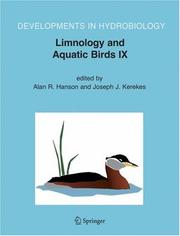
ISBN: 9781402055560 1402051670 9781402051678 9401782326 9786612047732 1282047736 1402055560 Year: 2006 Publisher: Dordrecht Springer
Abstract | Keywords | Export | Availability | Bookmark
 Loading...
Loading...Choose an application
- Reference Manager
- EndNote
- RefWorks (Direct export to RefWorks)
The importance of habitat conservation for the protection of birds has become widely acknowledged and accepted by natural resource managers and the general public. Papers presented in this volume further our understanding of the important role that limnology has in determining habitat suitability for waterbirds. Long-term population monitoring of waterbirds is an important tool in our quest to understand the role waterbirds play in their environment. Continued population declines of many species of aquatic birds indicate the need for additional understanding of how human activities negatively impact water quality and bird populations and what mitigative actions can be taken. The main objective of the Working Group on Aquatic Birds of the International Limnological Society (SIL) is to integrate waterbirds into hydrobiology and treat waterbird studies in a limnological context. To achieve this goal, the Working Group organizes conferences to facilitate communications among limnologists interested in aquatic birds and ornithologists interested in the aquatic habitat. The efforts of the SIL Working Group on aquatic birds has resulted in a new emphasis on the links between aquatic birds and their environment. This book is international in scope and presents information on species as diverse as common loon, harlequin duck, and semi-palmated sandpiper, and locations ranging from Iceland to Japan.
Life Sciences. --- Freshwater & Marine Ecology. --- Nature Conservation. --- Applied Ecology. --- Life sciences. --- Aquatic biology. --- Sciences de la vie --- Hydrobiologie --- Water birds. --- Water birds --- Limnology --- Ecology --- Vertebrates --- Earth & Environmental Sciences --- Zoology --- Health & Biological Sciences --- Habitat --- Food --- Aquatic birds --- Waterbirds --- Applied ecology. --- Aquatic ecology. --- Nature conservation. --- Aquatic animals --- Birds --- Environmental protection --- Nature conservation --- Conservation of nature --- Nature --- Nature protection --- Protection of nature --- Conservation of natural resources --- Applied ecology --- Conservation biology --- Endangered ecosystems --- Natural areas --- Hydrobiology --- Water biology --- Aquatic sciences --- Biology --- Conservation --- Aquatic ecology . --- Aquatic biology
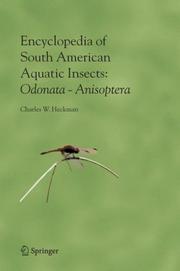
ISBN: 9781402048025 1280716436 9786610716432 1429414413 1402048025 1402048017 Year: 2006 Publisher: Dordrecht : Springer,
Abstract | Keywords | Export | Availability | Bookmark
 Loading...
Loading...Choose an application
- Reference Manager
- EndNote
- RefWorks (Direct export to RefWorks)
Anisoptera is the first of two volumes on the Odonata in the series Encyclopedia of South American Aquatic Insects. The second will treat the Zygoptera. The Anisoptera volume encompasses the large dragonfly species. A brief review of the biology of the group includes illustrations of the main morphological features as well as explanations of alternative systems for naming the wing veins and other structures. This will prepare the user of the volume to understand the different names for the same structures that he will encounter in the literature. The review is then followed by keys to facilitate identification of the adult dragonflies and the known larvae, allowing the user a high probability of identifying his specimens correctly. In addition to anatomical features, the keys include the known ranges of the species, synonyms, and citations of literature in which more information about each individual species can be obtained. These citations are compiled in an extensive bibliography, including titles of the original publications in which descriptions of almost all South American species appeared. Although taxonomic revisions are deliberately avoided, suggestions for additional research are provided where the validity of taxa seems doubtful. To provide the user with the best possible opportunity to distinguish the species, the keys are richly illustrated with pen and ink drawings of thousands of individual morphological structures arranged in 797 figures. It is certain that significant changes will occur in the systematics of South American dragonflies in the future, and this book should provide the impetus needed to accelerate the revisional work. Meanwhile, it will provide a comprehensive overview of the Anisoptera in South America that is otherwise unavailable to most South American scientists because of the great difficulties in obtaining the hundreds of publications from numerous countries in which the descriptions and revisions of the species appeared. It also provides young entomologists with a basic text for learning what they need to know to work effectively with the Anisoptera of South America and adjacent regions. Already published within this encyclopedia: -Encyclopedia of South American Aquatic Insects: Collembola ISBN: 0-7923-6704-9 -Encyclopedia of South American Aquatic Insects: Ephemeroptera ISBN: 1-4020-0775-2 -Encyclopedia of South American Aquatic Insects: Plecoptera ISBN: 1-4020-1520-8 Forthcoming book titles: Forthcoming book titles: -Encyclopedia of South American Aquatic Insects: Odonata - Zygoptera -Encyclopedia of South American Aquatic Insects: Orthoptera -Encyclopedia of South American Aquatic Insects: Heteroptera; -Encyclopedia of South American Aquatic Insects: Neuroptera, including Megaloptera -Encyclopedia of South American Aquatic Insects: Trichoptera -Encyclopedia of South American Aquatic Insects: Lepidoptera -Encyclopedia of South American Aquatic Insects: Coleoptera -Encyclopedia of South American Aquatic Insects: Diptera -Encyclopedia of South American Aquatic Insects: Hymenoptera.
dierenecologie --- hydrobiologie --- nomenclatuur --- Zoology --- zoölogie --- Animal systematics, taxonomy, nomencl. --- Hydrobiology --- Animal ethology and ecology. Sociobiology --- Odonata --- Dragonflies --- Anisoptera --- Libelluloidea --- Odes (Insects) --- Odonates --- Paraneuroptera --- Insects --- Entomology. --- Animal ecology. --- Aquatic biology. --- Zoology. --- Animal Ecology. --- Animal Systematics/Taxonomy/Biogeography. --- Freshwater & Marine Ecology. --- Biology --- Natural history --- Animals --- Water biology --- Aquatic sciences --- Ecology --- Animal systematics. --- Animal taxonomy. --- Aquatic ecology . --- Aquatic biology --- Animal classification --- Animal systematics --- Animal taxonomy --- Classification --- Systematic zoology --- Systematics (Zoology) --- Taxonomy, Animal --- Zoological classification --- Zoological systematics --- Zoological taxonomy
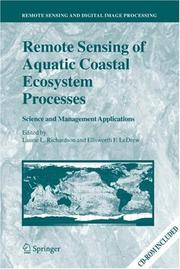
ISBN: 1280612584 9786610612581 1402039689 1402039670 9781402039676 9781402039683 9401784256 Year: 2006 Publisher: Dordrecht Springer
Abstract | Keywords | Export | Availability | Bookmark
 Loading...
Loading...Choose an application
- Reference Manager
- EndNote
- RefWorks (Direct export to RefWorks)
The aquatic coastal zone is one of the most challenging targets for environmental remote sensing. Properties such as bottom reflectance, spectrally diverse suspended sediments and phytoplankton communities, diverse benthic communities, and transient events that affect surface reflectance (coastal blooms, runoff, etc.) all combine to produce an optical complexity not seen in terrestrial or open ocean systems. Despite this complexity, remote sensing is proving to be an invaluable tool for "Case 2" waters. This book presents recent advances in coastal remote sensing with an emphasis on applied science and management. Case studies of the operational use of remote sensing in ecosystem studies, monitoring, and interfacing remote sensing/science/management are presented. Spectral signatures of phytoplankton and suspended sediments are discussed in detail with accompanying discussion of why blue water (Case 1) algorithms cannot be applied to Case 2 waters. Audience This book is targeted for scientists and managers interested in using remote sensing in the study or management of aquatic coastal environments. With only limited discussion of optics and theory presented in the book, such researchers might benefit from the detailed presentations of aquatic spectral signatures, and to operational management issues. While not specifically written for remote sensing scientists, it will prove to be a useful reference for this community for the current status of aquatic coastal remote sensing.
Remote sensing. --- Ecology. --- Remote-sensing imagery --- Remote sensing systems --- Remote terrain sensing --- Sensing, Remote --- Terrain sensing, Remote --- Aerial photogrammetry --- Aerospace telemetry --- Detectors --- Space optics --- Balance of nature --- Biology --- Bionomics --- Ecological processes --- Ecological science --- Ecological sciences --- Environment --- Environmental biology --- Oecology --- Environmental sciences --- Population biology --- Ecology --- Coastal ecology --- Aquatic biology. --- Environmental management. --- Algorithms. --- Remote Sensing/Photogrammetry. --- Freshwater & Marine Ecology. --- Environmental Management. --- Optics, Lasers, Photonics, Optical Devices. --- Algorism --- Algebra --- Arithmetic --- Environmental stewardship --- Stewardship, Environmental --- Management --- Hydrobiology --- Water biology --- Aquatic sciences --- Foundations --- Aquatic ecology . --- Lasers. --- Photonics. --- New optics --- Optics --- Light amplification by stimulated emission of radiation --- Masers, Optical --- Optical masers --- Light amplifiers --- Light sources --- Optoelectronic devices --- Nonlinear optics --- Optical parametric oscillators --- Aquatic biology
Book
ISBN: 1280800321 9786610800322 1402046979 Year: 2006 Publisher: Dordrecht ; [Great Britain] : Springer,
Abstract | Keywords | Export | Availability | Bookmark
 Loading...
Loading...Choose an application
- Reference Manager
- EndNote
- RefWorks (Direct export to RefWorks)
This volume presents selected contributions given to the 38th European Marine Biology Symposium, held in Aveiro, Portugal, in September 2003. Understanding the functioning of Marine Ecosystems is the first step to measure and predict the influence of Man, and to find solutions for the enormous array of problems we face today. This volume is organised according to the four subthemes of the symposium and to issues commonly perceived as relevant by scientists concerned with the study, protection and management of Marine Biodiversity: patterns and processes, assessment, threats and management and conservation. The 32 papers that make up this book represent the current research and concerns about Marine Biodiversity in Europe, and will have wide appeal to all those interested in understanding and preserving the marine ecosystems of the world's oceans. Reprinted from HYDROBIOLOGIA volume 555(2006).
Marine biodiversity --- Marine biodiversity conservation --- Conservation of marine biodiversity --- Marine biological diversity conservation --- Aquatic biodiversity conservation --- Marine resources conservation --- Diversity, Marine biological --- Marine biological diversity --- Aquatic biodiversity --- Conservation --- Nature Conservation. --- Biodiversity. --- Aquatic biology. --- Freshwater & Marine Ecology. --- Hydrobiology --- Water biology --- Aquatic sciences --- Biology --- Biological diversification --- Biological diversity --- Biotic diversity --- Diversification, Biological --- Diversity, Biological --- Biocomplexity --- Ecological heterogeneity --- Numbers of species --- Conservation of nature --- Nature --- Nature protection --- Protection of nature --- Conservation of natural resources --- Applied ecology --- Conservation biology --- Endangered ecosystems --- Natural areas --- Nature conservation. --- Aquatic ecology . --- Aquatic biology --- Ecology
| Listing 1 - 10 of 25 | << page >> |
Sort by
|

 Search
Search Feedback
Feedback About UniCat
About UniCat  Help
Help News
News